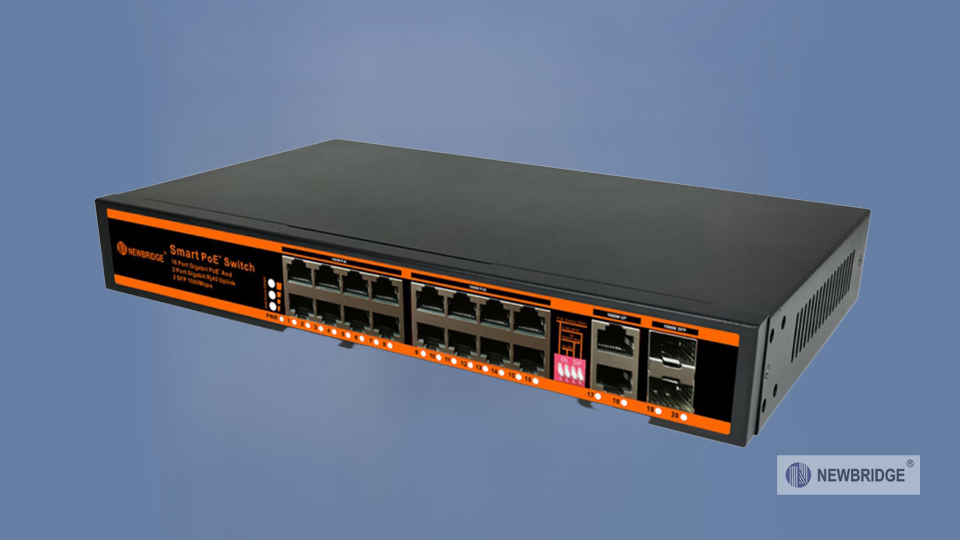PoE (Power over Ethernet) switches are widely used in security monitoring, wireless coverage, and other scenarios due to their ability to simultaneously transmit data and power. Among the many indicators for measuring the performance of PoE switches, backplane bandwidth is an easily overlooked but crucial parameter. It is like the "digital highway" of switches, determining the data processing and transmission capabilities of switches, directly affecting the operational efficiency and stability of the entire network.

1、 The concept of backplane bandwidth
Backplane bandwidth refers to the maximum amount of data that can be throughput between the PoE switch interface processor or interface card and the data bus, typically measured in Gbps (gigabits per second). You can imagine a PoE switch as a large transportation hub, and the backplane bandwidth is the width of the main road in this hub. The wider the main road, the more vehicles (data) passing through at the same time, and the larger the amount of data that the switch processes and forwards at the same time.
PoE switches need to handle data transmission and power transmission from multiple ports simultaneously during operation. When multiple ports simultaneously receive a large amount of data that needs to be forwarded to other ports, backplane bandwidth plays a critical role. If the backplane bandwidth is insufficient, data will experience congestion, queuing and waiting for forwarding like vehicles driving on narrow roads, leading to increased network latency and packet loss rate, seriously affecting network performance.
2、 The Importance of Backplane Bandwidth in PoE Switches
(1) Ensure efficient data transmission
For network environments with a large number of IP cameras, wireless APs, and other devices deployed, PoE switches need to simultaneously power these devices and transmit a large amount of information such as real-time video streams and user internet data. Taking a monitoring system as an example, assuming that the bitrate of each IP camera is 4Mbps, a 24 port PoE switch is connected to 20 cameras, and these cameras simultaneously upload video data to the monitoring center. If the backplane bandwidth is insufficient, data transmission will be blocked, and monitoring screens may experience lag, delay, or even fail to display properly, seriously affecting the effectiveness of the monitoring system. And a PoE switch with sufficient backplane bandwidth can ensure that these data pass through the switch quickly and smoothly, achieving seamless video transmission and stable network connection, ensuring the normal operation of the entire monitoring system.
(2) Enhance network stability
In enterprise network environments, PoE switches typically connect various devices such as office computers and IP phones. These devices frequently exchange data during operation, such as file transfers, video conferences, voice calls, etc. When network traffic suddenly increases, such as multiple users simultaneously downloading large files or holding video conferences, PoE switches with high backplane bandwidth can handle this sudden increase in traffic calmly, ensuring normal data forwarding and maintaining stable network operation. On the contrary, if the backplane bandwidth is low, the switch may experience downtime, restarts, and other failures due to the inability to process large amounts of data in a timely manner, resulting in network interruptions and seriously affecting the daily office operations of the enterprise.
(3) Support future network expansion
With the continuous development of network technology and the growth of enterprise business, the number of network devices and data traffic will continue to increase. If the selected PoE switch backplane bandwidth is low during the initial deployment of the network, existing switches may not be able to meet higher data processing requirements when the network scale expands and new devices are connected. Choosing a PoE switch with a higher backplane bandwidth can reserve enough space for future network expansion. Even if more devices are added and network bandwidth is increased in the future, the switch can maintain good performance, avoid frequent replacement of switches due to device upgrades, and reduce network construction and maintenance costs.
3、 Calculation and selection of backplane bandwidth
(1) Calculation method
There is a certain standard formula for calculating the bandwidth of the backplane. For layer 2 switches, the calculation formula for backplane bandwidth is: backplane bandwidth (Gbps)=number of ports x port rate (Gbps) x 2 (full duplex mode). For example, a 24 port Gigabit PoE switch should theoretically have a backplane bandwidth of at least 48Gbps, which is 24 × 1 × 2. For layer 3 switches, the calculation method will be more complex and additional data processing requirements such as routing and forwarding need to be considered.
(2) Choose Suggestions
When choosing a PoE switch, it is not enough to simply meet the theoretical minimum backplane bandwidth requirement. In order to ensure good performance and sufficient expansion space of the network, products with backplane bandwidth higher than the theoretical value should be selected as much as possible. If it is a small network environment, such as a home or small office, with relatively low requirements for network performance, a PoE switch with a backplane bandwidth slightly higher than the theoretical calculation value can be selected. For scenarios such as large enterprise networks and data centers that require high network performance, it is necessary to choose high-end PoE switches with backplane bandwidth much higher than theoretical values to cope with complex network environments and large data transmission demands.
Backplane bandwidth is one of the core performance indicators of PoE switches. It is like the "heart" of the switch, providing power for efficient data transmission and stable network operation. When selecting and deploying PoE switches, fully considering the factor of backplane bandwidth can build an efficient, stable, and scalable network environment for users, meeting network needs in different scenarios. With the continuous advancement of network technology, the demand for PoE switch backplane bandwidth will also become increasingly high. Only by attaching importance to this indicator can the network better serve our lives and work.
